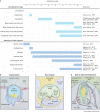Zika virus infection histories in brain development
- PMID: 37458166
- PMCID: PMC10387348
- DOI: 10.1242/dmm.050005
Zika virus infection histories in brain development
Abstract
An outbreak of births of microcephalic patients in Brazil motivated multiple studies on this incident. The data left no doubt that infection by Zika virus (ZIKV) was the cause, and that this virus promotes reduction in neuron numbers and neuronal death. Analysis of patients' characteristics revealed additional aspects of the pathology alongside the decrease in neuronal number. Here, we review the data from human, molecular, cell and animal model studies attempting to build the natural history of ZIKV in the embryonic central nervous system (CNS). We discuss how identifying the timing of infection and the pathways through which ZIKV may infect and spread through the CNS can help explain the diversity of phenotypes found in congenital ZIKV syndrome (CZVS). We suggest that intraneuronal viral transport is the primary mechanism of ZIKV spread in the embryonic brain and is responsible for most cases of CZVS. According to this hypothesis, the viral transport through the blood-brain barrier and cerebrospinal fluid is responsible for more severe pathologies in which ZIKV-induced malformations occur along the entire anteroposterior CNS axis.
Keywords: Blood–brain barrier; Brainstem; Calcification; Cerebellum; Neuronal migration; Susceptibility window.
© 2023. Published by The Company of Biologists Ltd.
Conflict of interest statement
Competing interests The authors declare no competing or financial interests.
Figures



Similar articles
-
Progressive lesions of central nervous system in microcephalic fetuses with suspected congenital Zika virus syndrome.Ultrasound Obstet Gynecol. 2017 Dec;50(6):717-722. doi: 10.1002/uog.17303. Epub 2017 Nov 8. Ultrasound Obstet Gynecol. 2017. PMID: 27644020
-
Zika virus infects pericytes in the choroid plexus and enters the central nervous system through the blood-cerebrospinal fluid barrier.PLoS Pathog. 2020 May 1;16(5):e1008204. doi: 10.1371/journal.ppat.1008204. eCollection 2020 May. PLoS Pathog. 2020. PMID: 32357162 Free PMC article.
-
In situ inflammasome activation results in severe damage to the central nervous system in fatal Zika virus microcephaly cases.Cytokine. 2018 Nov;111:255-264. doi: 10.1016/j.cyto.2018.08.008. Epub 2018 Sep 8. Cytokine. 2018. PMID: 30199767
-
Zika infection and the development of neurological defects.Cell Microbiol. 2017 Jun;19(6). doi: 10.1111/cmi.12744. Epub 2017 May 3. Cell Microbiol. 2017. PMID: 28370966 Review.
-
Potential mechanisms of Zika-linked microcephaly.Wiley Interdiscip Rev Dev Biol. 2017 Jul;6(4):e273. doi: 10.1002/wdev.273. Epub 2017 Apr 6. Wiley Interdiscip Rev Dev Biol. 2017. PMID: 28383800 Free PMC article. Review.
Cited by
-
Supporting the evolution of infectious disease research.Dis Model Mech. 2024 Sep 1;17(9):dmm052112. doi: 10.1242/dmm.052112. Epub 2024 Oct 1. Dis Model Mech. 2024. PMID: 39352121 Free PMC article.
-
Application of diceCT to Study the Development of the Zika Virus-Infected Mouse Brain.Viruses. 2024 Aug 20;16(8):1330. doi: 10.3390/v16081330. Viruses. 2024. PMID: 39205304 Free PMC article.
References
-
- Acosta-Reyes, J., Navarro, E., Herrera, M. J., Goenaga, E., Ospina, M. L., Parra, E., Mercado, M., Chaparro, P., Beltran, M., Gunturiz, M. L.et al. ( 2017). Severe neurologic disorders in 2 fetuses with Zika virus infection, Colombia. Emerg. Infect. Dis. 23, 982- 984. 10.3201/eid2306.161702 - DOI - PMC - PubMed
-
- Aguiar, R. S., Pohl, F., Morais, G. L., Nogueira, F. C. S., Carvalho, J. B., Guida, L., Arge, L. W. P., Melo, A., Moreira, M. E. L., Cunha, D. P.et al. ( 2020). Molecular alterations in the extracellular matrix in the brains of newborns with congenital Zika syndrome. Sci. Signal 13, eaay6736. 10.1126/scisignal.aay6736 - DOI - PubMed
-
- Anderson, D., Neri, J. I. C. F., Souza, C. R. M., Valverde, J. G., De Araújo, J. M. G., Nascimento, M. D. S. B., Branco, R. C. C., Arrais, N. M. R., Lassmann, T., Blackwell, J. M.et al. ( 2021). Zika virus changes methylation of genes involved in immune response and neural development in brazilian babies born with congenital microcephaly. J. Infect. Dis. 223, 435- 440. 10.1093/infdis/jiaa383 - DOI - PubMed
Publication types
MeSH terms
LinkOut - more resources
Full Text Sources
Medical

